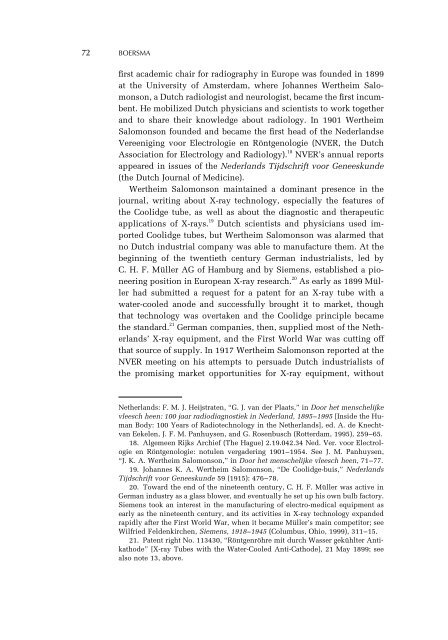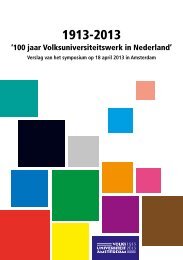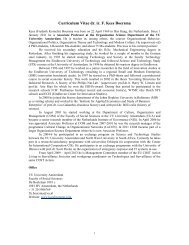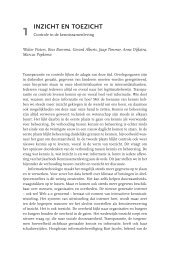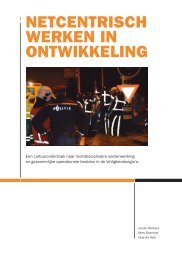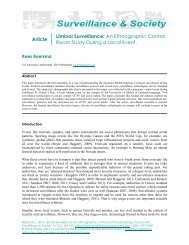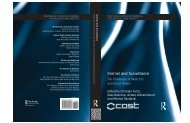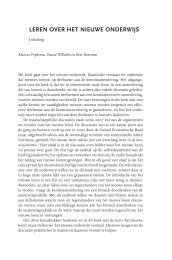Access article in PDF - Project MUSE - Johns Hopkins University
Access article in PDF - Project MUSE - Johns Hopkins University
Access article in PDF - Project MUSE - Johns Hopkins University
You also want an ePaper? Increase the reach of your titles
YUMPU automatically turns print PDFs into web optimized ePapers that Google loves.
72 BOERSMA<br />
first academic chair for radiography <strong>in</strong> Europe was founded <strong>in</strong> 1899<br />
at the <strong>University</strong> of Amsterdam, where Johannes Wertheim Salomonson,<br />
a Dutch radiologist and neurologist, became the first <strong>in</strong>cumbent.<br />
He mobilized Dutch physicians and scientists to work together<br />
and to share their knowledge about radiology. In 1901 Wertheim<br />
Salomonson founded and became the first head of the Nederlandse<br />
Vereenig<strong>in</strong>g voor Electrologie en Röntgenologie (NVER, the Dutch<br />
Association for Electrology and Radiology). 18 NVER’s annual reports<br />
appeared <strong>in</strong> issues of the Nederlands Tijdschrift voor Geneeskunde<br />
(the Dutch Journal of Medic<strong>in</strong>e).<br />
Wertheim Salomonson ma<strong>in</strong>ta<strong>in</strong>ed a dom<strong>in</strong>ant presence <strong>in</strong> the<br />
journal, writ<strong>in</strong>g about X-ray technology, especially the features of<br />
the Coolidge tube, as well as about the diagnostic and therapeutic<br />
applications of X-rays. 19 Dutch scientists and physicians used imported<br />
Coolidge tubes, but Wertheim Salomonson was alarmed that<br />
no Dutch <strong>in</strong>dustrial company was able to manufacture them. At the<br />
beg<strong>in</strong>n<strong>in</strong>g of the twentieth century German <strong>in</strong>dustrialists, led by<br />
C. H. F. Müller AG of Hamburg and by Siemens, established a pioneer<strong>in</strong>g<br />
position <strong>in</strong> European X-ray research. 20 As early as 1899 Müller<br />
had submitted a request for a patent for an X-ray tube with a<br />
water-cooled anode and successfully brought it to market, though<br />
that technology was overtaken and the Coolidge pr<strong>in</strong>ciple became<br />
the standard. 21 German companies, then, supplied most of the Netherlands’<br />
X-ray equipment, and the First World War was cutt<strong>in</strong>g off<br />
that source of supply. In 1917 Wertheim Salomonson reported at the<br />
NVER meet<strong>in</strong>g on his attempts to persuade Dutch <strong>in</strong>dustrialists of<br />
the promis<strong>in</strong>g market opportunities for X-ray equipment, without<br />
Netherlands: F. M. J. Heijstraten, “G. J. van der Plaats,” <strong>in</strong> Door het menschelijke<br />
vleesch heen: 100 jaar radiodiagnostiek <strong>in</strong> Nederland, 1895–1995 [Inside the Human<br />
Body: 100 Years of Radiotechnology <strong>in</strong> the Netherlands], ed. A. de Knechtvan<br />
Eekelen, J. F. M. Panhuysen, and G. Rosenbusch (Rotterdam, 1995), 259–65.<br />
18. Algemeen Rijks Archief (The Hague) 2.19.042.34 Ned. Ver. voor Electrologie<br />
en Röntgenologie: notulen vergader<strong>in</strong>g 1901–1954. See J. M. Panhuysen,<br />
“J. K. A. Wertheim Salomonson,” <strong>in</strong> Door het menschelijke vleesch heen, 71–77.<br />
19. Johannes K. A. Wertheim Salomonson, “De Coolidge-buis,” Nederlands<br />
Tijdschrift voor Geneeskunde 59 (1915): 476–78.<br />
20. Toward the end of the n<strong>in</strong>eteenth century, C. H. F. Müller was active <strong>in</strong><br />
German <strong>in</strong>dustry as a glass blower, and eventually he set up his own bulb factory.<br />
Siemens took an <strong>in</strong>terest <strong>in</strong> the manufactur<strong>in</strong>g of electro-medical equipment as<br />
early as the n<strong>in</strong>eteenth century, and its activities <strong>in</strong> X-ray technology expanded<br />
rapidly after the First World War, when it became Müller’s ma<strong>in</strong> competitor; see<br />
Wilfried Feldenkirchen, Siemens, 1918–1945 (Columbus, Ohio, 1999), 311–15.<br />
21. Patent right No. 113430, “Röntgenröhre mit durch Wasser gekühlter Antikathode”<br />
[X-ray Tubes with the Water-Cooled Anti-Cathode], 21 May 1899; see<br />
also note 13, above.


